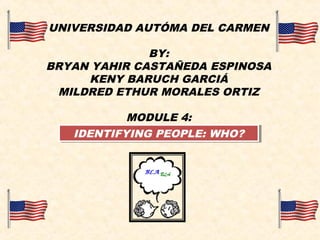English For Open High School - Module 4
- 1. UNIVERSIDAD AUT?MA DEL CARMEN BY: BRYAN YAHIR CASTA?EDA ESPINOSA KENY BARUCH GARCI? MILDRED ETHUR MORALES ORTIZ MODULE 4: IDENTIFYING PEOPLE: WHO?IDENTIFYING PEOPLE: WHO?
- 2. Who? QuestionsQuestions Who + am /is /are + nominative subject Who are you? Who is he? Who is she? Pedro (Father) Mark (Son) Lisa (Daughter) ?For asking the identification of people in question begins with the word Ī░whoĪ▒. ?The contraction of who is ©C whoĪ»s and who are ©C whoĪ»re. ?The conjugation of verb TO BE: I (am), he, she, it (is) and you, they (are).
- 3. ?for giving identification of people by names. AnswersAnswers Subject + am / is / are + personĪ»s name I Am Pedro He Is Mark She Is Lisa Who + am /is /are + personĪ»s name ?for asking identification of people whose names are known. QuestionQuestion Who Is Pedro Who Is Mark Who Are Lisa
- 4. ?For giving identification of one or more people for their family relationship, whether, some type of social relationship with other person. Subject + am /is /are + personĪ»s name + relationship I Am PedroĪ»s and LisaĪ»s father He Is LisaĪ»s brother The Are MarkĪ»s sons The personĪ»s name which is the point of reference is followed by Ī«S, but, when the name ends in SĪ» only take a apostrophe. Name + sĪ» + family relationship
- 5. Family Vocabulary Father Mother Husband Wife Daughter Son Brother Sister Nephew Niece Uncle Aunt Father in law Daughter in law Brother in law Sister in law Grandfather Grandmother Grandson Granddaughter Parents Cousin Grandchildren Parents in law
- 6. ?For giving identification of one or several people or things by means of belongings or possessions. Subject +am /is /are + possessive adjective + possessive object He has a car. It is his car They have shoes. They are their shoes We have a baby. He is our baby
- 7. Subject pronouns Possessive adjectives I My You Your He His She Her It Its We Our You Your They Their POSSESSIVE ADJECTIVES We use possessive adjectives to show who owns or Ī░possessesĪ▒ something.
- 8. References ?Banderas Animadas de Estados Unidos. (n.d.). Flags Animados de Estados Unidos de Am©”rica. Retrieved July 5, 2014, from http://www.gifss.com/banderas/estados/index6.htm ?Gifs animados de personas hablando. (n.d.). Gifsanimados de RSS. Retrieved July 5, 2014, from http://gifsanimados.de/personas+hablando ?Family. (n.d.). Family. Retrieved July 5, 2014, from http://1.bp.blogspot.com/- rrcuU8rmP9w/UCI2tK0QlsI/AAAAAAAABpM/8u5ReC2rGVA/s1600/fa mily.png
- 9. ?Gifs animados gratis de coches, auto, carro, autom©«vil ©C im©ógenes con movimiento de coches, auto, carro, autom©«vil. (n.d.). Gifts animados gratis de coches auto, carro, autom©«vil ©C im©ógenes con movimiento de coches, auto, carro, autom©«vil. Retrieved July 5, 2014, from http://www.100pies.net/gifs/Transporte- Terrestre/Coches.asp?Page=4 ?Gifs Animados I Im©ógenes de Escuela (Gifs animados). (n.d.). Gifs Animados I Im©ógenes de Escuela (Gifs animados). Retrieved July 5, 2014, from http://www.gifs.com.es/Escuela/
- 10. ?Gifs animados gratis de coches, auto, carro, autom©«vil ©C im©ógenes con movimiento de coches, auto, carro, autom©«vil. (n.d.). Gifts animados gratis de coches auto, carro, autom©«vil ©C im©ógenes con movimiento de coches, auto, carro, autom©«vil. Retrieved July 5, 2014, from http://www.100pies.net/gifs/Transporte- Terrestre/Coches.asp?Page=4 ?Gifs Animados I Im©ógenes de Escuela (Gifs animados). (n.d.). Gifs Animados I Im©ógenes de Escuela (Gifs animados). Retrieved July 5, 2014, from http://www.gifs.com.es/Escuela/









